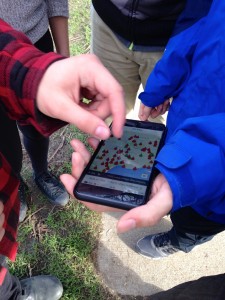I have taught social studies and physical education at Kitsilano Secondary School in Vancouver since 1988. My interest in educational technology began soon after I enrolled in Emily Carr University of Art and Design in 2000, where I experienced my first online course.  I was surprised and impressed by the exchange of ideas that I had with my classmates through the Moodle discussions. In a subsequent lecture-based class, the instructor had all of the course notes posted on his website, which we were encouraged to read and print prior to coming to class. Although this seems common by today’s standards, it was a revelation to me. I was still writing-out notes using an overhead projector in my own classes and basing my content on incomplete sets of textbooks. By 2003, I had my own class website on the old Apple iWeb platform. In 2004, I attended a summer geotechnical education conference that focused on geographic information systems (GIS) and global positions systems (GPS). By that point I was seeking-out technology in all part of my teaching practice.
I was surprised and impressed by the exchange of ideas that I had with my classmates through the Moodle discussions. In a subsequent lecture-based class, the instructor had all of the course notes posted on his website, which we were encouraged to read and print prior to coming to class. Although this seems common by today’s standards, it was a revelation to me. I was still writing-out notes using an overhead projector in my own classes and basing my content on incomplete sets of textbooks. By 2003, I had my own class website on the old Apple iWeb platform. In 2004, I attended a summer geotechnical education conference that focused on geographic information systems (GIS) and global positions systems (GPS). By that point I was seeking-out technology in all part of my teaching practice.
When I look back on it, my Emily Carr experience allowed me to accept ambiguity and mistakes as an important learning process, introduced me to the processes of collaboration and critique, and encouraged me to experiment. As a result, in my teaching practice I have handled technology detractors and unsuccessful lesson ventures well, while at the same time seeking out new possibilities in learning.
One of my main goals for ETEC 565A is to become proficient at evaluating and selecting appropriate technologies, web tools and media for myself and in a consultative role for my school. My immediate concern is to choose an LMS for the blended Geography 12 course that I am teaching in the fall. The Vancouver School Board can give me access to Moodle and D2L but I have some reservations with both of them. I am recognizing in the early going with 565A that a companion website may offer more flexibility. A related goal is to become adept and confident in the process of connecting learning outcomes to technology choices. Similarly, I want to be able to make the most appropriate decisions given the constraints of site limitations, money and professional development time. I also want to be able to defend my decisions to critical administrators and colleagues who want to spend limited funds on products that lack an educational focus.
I hope to learn strategies of how to weigh the affordances and constraints of different technologies that are flexible enough to keep pace with future developments. Specifically, I would like to have a better understanding of the scope of assessment options available and what constitutes a fair price.  Our school as an account with Turnitin, which has impressive assessment tools built into it, including: quick mark drag-and-drop comments, text and voice feedback, point and click rubrics that are connect to grades, and a peer reviewing function. The problem is that the cost does not warrant how many teachers use it. I am interested in how to evaluate other similar services that may be a better fit. I am also interested in learning a set of best practices to deal with the plethora of presentation and media tools that students use every year. Many of them require creating an account to view them, or they have sharing limitations that interfere with the viewing and assessment processes. Finally, I want to learn more about how mobile game-based learning can be integrated into online management and assessment platforms.
Our school as an account with Turnitin, which has impressive assessment tools built into it, including: quick mark drag-and-drop comments, text and voice feedback, point and click rubrics that are connect to grades, and a peer reviewing function. The problem is that the cost does not warrant how many teachers use it. I am interested in how to evaluate other similar services that may be a better fit. I am also interested in learning a set of best practices to deal with the plethora of presentation and media tools that students use every year. Many of them require creating an account to view them, or they have sharing limitations that interfere with the viewing and assessment processes. Finally, I want to learn more about how mobile game-based learning can be integrated into online management and assessment platforms.
The skills that I hope to gain during this course have to do with connectivity and communication. My social media skills are weak. I have heeded the warnings of the Union and stayed away from Facebook and Instagram, but I worry that I may be missing an opportunity. I have tried to use Twitter as an alternative but I gave-up after two years because only 30% of students would buy-in. It is one thing to use social media periodically and another to be a member of culture of social media. The abbreviations, tags, memes, “likes” and even the positioning of “@’s” in a post are important cues that tacitly affect how a message is received by others. I also need the skills to take advantage of the share and groups functions on such web tools as Evernote, Dropbox or Youtube, which would connect me to different learning communities, in order to encourage students to do the same. I am guilty of only using a narrow range of functions available in communications tools like Hangouts, Skype and Google Drive collaborations. I need to invest time playing selected mobile games so that I can better assess their connections to learning outcomes.
Our school has subscribed to ESRI’s ArcOnline GIS. My plan is to familiarize my blended Geography 12 class with this industry standard software so that they can learn in an authentic context; however, I need to invest time to learn it myself. I know that it includes integrations to some LMS platforms. I authored a mobile game on the ARIS (augmented reality interactive storytelling) app platform this year and plan to improve my skills and awareness of its potential. I am attending their summit and the Games+Learning+Society Conference at the University of Wisconsin in July.
It is uncanny how well timed this course is for me with the prospect of teaching a blended course in September. I am anticipating that it can help me to meet my goals, expand my learning and improve my skill set evaluating a range of educational technologies.
Hi Craig. You have given a great description of what you hope to gain from this course. I find it so useful to read a perspective such as yours because you’re a good number of steps ahead of me on this edtech journey and there is much I can learn from your experiences. Thanks for sharing!
-Pam